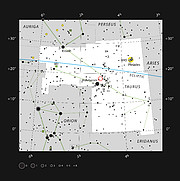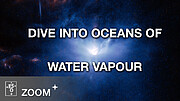Press Release
Astronomers reveal a new link between water and planet formation
29 February 2024
Researchers have found water vapour in the disc around a young star exactly where planets may be forming. Water is a key ingredient for life on Earth, and is also thought to play a significant role in planet formation. Yet, until now, we had never been able to map how water is distributed in a stable, cool disc — the type of disc that offers the most favourable conditions for planets to form around stars. The new findings were made possible thanks to the Atacama Large Millimeter/submillimeter Array (ALMA), in which the European Southern Observatory (ESO) is a partner.
“I had never imagined that we could capture an image of oceans of water vapour in the same region where a planet is likely forming,” says Stefano Facchini, an astronomer at the University of Milan, Italy, who led the study published today in Nature Astronomy. The observations reveal at least three times as much water as in all of Earth’s oceans in the inner disc of the young Sun-like star HL Tauri, located 450 light-years away from Earth in the constellation Taurus.
“It is truly remarkable that we can not only detect but also capture detailed images and spatially resolve water vapour at a distance of 450 light-years from us ,” adds co-author Leonardo Testi, an astronomer at the University of Bologna, Italy. The ‘spatially resolved’ observations with ALMA allow astronomers to determine the distribution of water in different regions of the disc. “Taking part in such an important discovery in the iconic HL Tauri disc was beyond what I had ever expected for my first research experience in astronomy,” adds Mathieu Vander Donckt from the University of Liège, Belgium, who was a master’s student when he participated in the research.
A significant amount of water was found in the region where a known gap in the HL Tauri disc exists. Ring-shaped gaps are carved out in gas- and dust-rich discs by orbiting young planet-like bodies as they gather up material and grow. “Our recent images reveal a substantial quantity of water vapour at a range of distances from the star that include a gap where a planet could potentially be forming at the present time,” says Facchini. This suggests that this water vapour could affect the chemical composition of planets forming in those regions.
Observing water with a ground-based telescope is no mean feat as the abundant water vapour in Earth’s atmosphere degrades the astronomical signals. ALMA, operated by ESO together with its international partners, is an array of telescopes in the Chilean Atacama Desert at about 5000 metres elevation that was built in a high and dry environment specifically to minimise this degradation, providing exceptional observing conditions. “To date, ALMA is the only facility able to spatially resolve water in a cool planet-forming disc,” says co-author Wouter Vlemmings, a professor at the Chalmers University of Technology in Sweden [1].
“It is truly exciting to directly witness, in a picture, water molecules being released from icy dust particles,” says Elizabeth Humphreys, an astronomer at ESO who also participated in the study. The dust grains that make up a disc are the seeds of planet formation, colliding and clumping into ever larger bodies orbiting the star. Astronomers believe that where it is cold enough for water to freeze onto dust particles, things stick together more efficiently — an ideal spot for planet formation. “Our results show how the presence of water may influence the development of a planetary system, just like it did some 4.5 billion years ago in our own Solar System,” Facchini adds.
With upgrades happening at ALMA and ESO’s Extremely Large Telescope (ELT) coming online within the decade, planet formation and the role water plays in it will become clearer than ever. In particular METIS, the Mid-infrared ELT Imager and Spectrograph, will give astronomers unrivalled views of the inner regions of planet-forming discs, where planets like Earth form.
Notes
[1] The new observations used the Band 5 and Band 7 receivers on ALMA. Bands 5 and 7 were European developments, at Chalmers/NOVA (Netherlands Research School for Astronomy) and IRAM (Institut de radioastronomie millimétrique), respectively, with involvement of ESO. Band 5 expanded ALMA into a new frequency range specifically for detecting and imaging water in the local Universe. In this study, the team observed three spectral lines of water across the two receiver frequency ranges to map gas at different temperatures within the disc.
More information
This research was presented in a paper titled “Resolved ALMA observations of water in the inner astronomical units of the HL Tau disk” to appear in Nature Astronomy (doi:10.1038/s41550-024-02207-w).
The team is composed of S. Facchini (Dipartimento di Fisica, Università degli Studi di Milano, Italy), L. Testi (Dipartimento di Fisica e Astronomia “Augusto Righi”, Università di Bologna, Italy), E. Humphreys (European Southern Observatory, Germany, Joint ALMA Observatory, Chile; European Southern Observatory Vitacura, Chile), M. Vander Donckt (Space sciences, Technologies & Astrophysics Research (STAR) Institute, University of Liège, Belgium), A. Isella (Department of Physics and Astronomy, Rice University, USA [Rice]), R. Wrzosek (Rice), A. Baudry (Laboratoire d’Astrophysique de Bordeaux, Univ. de Bordeaux, CNRS, France), M. D. Gray (National Astronomical Research Institute of Thailand, Thailand), A. M. S. Richards (JBCA, University of Manchester, UK), W. Vlemmings (Department of Space, Earth and Environment, Chalmers University of Technology, Sweden).
The Atacama Large Millimeter/submillimeter Array (ALMA), an international astronomy facility, is a partnership of ESO, the U.S. National Science Foundation (NSF) and the National Institutes of Natural Sciences (NINS) of Japan in cooperation with the Republic of Chile. ALMA is funded by ESO on behalf of its Member States, by NSF in cooperation with the National Research Council of Canada (NRC) and the National Science and Technology Council (NSTC) in Taiwan and by NINS in cooperation with the Academia Sinica (AS) in Taiwan and the Korea Astronomy and Space Science Institute (KASI). ALMA construction and operations are led by ESO on behalf of its Member States; by the National Radio Astronomy Observatory (NRAO), managed by Associated Universities, Inc. (AUI), on behalf of North America; and by the National Astronomical Observatory of Japan (NAOJ) on behalf of East Asia. The Joint ALMA Observatory (JAO) provides the unified leadership and management of the construction, commissioning and operation of ALMA.
Links
- Research paper (pre-print version, with provisional title)
- Photos of ALMA
- Find out more about ESO's Extremely Large Telescope on our dedicated website and press kit
- For journalists: subscribe to receive our releases under embargo in your language
- For scientists: got a story? Pitch your research
Contacts
Stefano Facchini
University of Milan
Milan, Italy
Tel: +39 02 503 17254
Email: stefano.facchini@unimi.it
Elizabeth Humphreys
European Southern Observatory
Garching bei München, Germany
Tel: +49 89 3200 6541
Email: ehumphre@eso.org
Leonardo Testi
University of Bologna
Bologna, Italy
Tel: +39 051 20 9 5763
Email: leonardo.testi@unibo.it
Mathieu Vander Donckt
University of Liege
Liege, Belgium
Tel: +32 4 366 9721
Email: Mathieu.VanderDonckt@uliege.be
Wouter Vlemmings
Chalmers University of Technology
Gothenburg, Sweden
Tel: +46 31 772 63 54
Email: wouter.vlemmings@chalmers.se
Bárbara Ferreira
ESO Media Manager
Garching bei München, Germany
Tel: +49 89 3200 6670
Cell: +49 151 241 664 00
Email: press@eso.org
About the Release
| Release No.: | eso2404 |
| Facility: | Atacama Large Millimeter/submillimeter Array |
| Science data: | 2024NatAs...8..587F |
Our use of Cookies
We use cookies that are essential for accessing our websites and using our services. We also use cookies to analyse, measure and improve our websites’ performance, to enable content sharing via social media and to display media content hosted on third-party platforms.
ESO Cookies Policy
The European Organisation for Astronomical Research in the Southern Hemisphere (ESO) is the pre-eminent intergovernmental science and technology organisation in astronomy. It carries out an ambitious programme focused on the design, construction and operation of powerful ground-based observing facilities for astronomy.
This Cookies Policy is intended to provide clarity by outlining the cookies used on the ESO public websites, their functions, the options you have for controlling them, and the ways you can contact us for additional details.
What are cookies?
Cookies are small pieces of data stored on your device by websites you visit. They serve various purposes, such as remembering login credentials and preferences and enhance your browsing experience.
Categories of cookies we use
Essential cookies (always active): These cookies are strictly necessary for the proper functioning of our website. Without these cookies, the website cannot operate correctly, and certain services, such as logging in or accessing secure areas, may not be available; because they are essential for the website’s operation, they cannot be disabled.
Functional Cookies: These cookies enhance your browsing experience by enabling additional features and personalization, such as remembering your preferences and settings. While not strictly necessary for the website to function, they improve usability and convenience; these cookies are only placed if you provide your consent.
Analytics cookies: These cookies collect information about how visitors interact with our website, such as which pages are visited most often and how users navigate the site. This data helps us improve website performance, optimize content, and enhance the user experience; these cookies are only placed if you provide your consent. We use the following analytics cookies.
Matomo Cookies:
This website uses Matomo (formerly Piwik), an open source software which enables the statistical analysis of website visits. Matomo uses cookies (text files) which are saved on your computer and which allow us to analyze how you use our website. The website user information generated by the cookies will only be saved on the servers of our IT Department. We use this information to analyze www.eso.org visits and to prepare reports on website activities. These data will not be disclosed to third parties.
On behalf of ESO, Matomo will use this information for the purpose of evaluating your use of the website, compiling reports on website activity and providing other services relating to website activity and internet usage.
Matomo cookies settings:
Additional Third-party cookies on ESO websites: some of our pages display content from external providers, e.g. YouTube.
Such third-party services are outside of ESO control and may, at any time, change their terms of service, use of cookies, etc.
YouTube: Some videos on the ESO website are embedded from ESO’s official YouTube channel. We have enabled YouTube’s privacy-enhanced mode, meaning that no cookies are set unless the user actively clicks on the video to play it. Additionally, in this mode, YouTube does not store any personally identifiable cookie data for embedded video playbacks. For more details, please refer to YouTube’s embedding videos information page.
Cookies can also be classified based on the following elements.
Regarding the domain, there are:
- First-party cookies, set by the website you are currently visiting. They are stored by the same domain that you are browsing and are used to enhance your experience on that site;
- Third-party cookies, set by a domain other than the one you are currently visiting.
As for their duration, cookies can be:
- Browser-session cookies, which are deleted when the user closes the browser;
- Stored cookies, which stay on the user's device for a predetermined period of time.
How to manage cookies
Cookie settings: You can modify your cookie choices for the ESO webpages at any time by clicking on the link Cookie settings at the bottom of any page.
In your browser: If you wish to delete cookies or instruct your browser to delete or block cookies by default, please visit the help pages of your browser:
Please be aware that if you delete or decline cookies, certain functionalities of our website may be not be available and your browsing experience may be affected.
You can set most browsers to prevent any cookies being placed on your device, but you may then have to manually adjust some preferences every time you visit a site/page. And some services and functionalities may not work properly at all (e.g. profile logging-in, shop check out).
Updates to the ESO Cookies Policy
The ESO Cookies Policy may be subject to future updates, which will be made available on this page.
Additional information
For any queries related to cookies, please contact: pdprATesoDOTorg.
As ESO public webpages are managed by our Department of Communication, your questions will be dealt with the support of the said Department.






